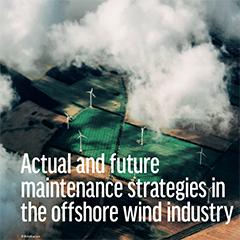During recent times we have seen huge investments worldwide into the design and installation of wind turbines both on and offshore. This trend is set to continue in the coming years. As well as developments in the power range, there has also been some dramatic changes to the equipment needed to install these assets.
Strategies to maintain the equipment also developed, but in many cases still focussed on increasing the efficiency of existing methodologies and optimizing logistic chains. Building expensive and fuel consuming assets, which leads to additional emissions. It also means a huge number of technicians, specialized in working at sea in challenging environments: working at height, in enclosed spaces, requiring expensive equipment to walk over from the vessels to the installations.
David Knukkel, CEO of RIMS (Robotics in Maintenance Strategies) explained, ‘we have to look differently at wind turbine maintenance in general. We are in the middle of the 4th industrial revolution and there is a huge amount of technology available on the market. It is, however, hidden in different domains, fragmented and there is a lack of people who have a holistic view and the capabilities to integrate the technology into a product, which creates value in the industry. We must invest in products, which we don’t need to go to sea to use, we would only need to be done as a last resort.’
David has a background as Marine Engineer and Maintenance Engineer/Maintenance Consultant. In 2015 he founded RIMS, and started to scout for new technology to automate dangerous and expensive maintenance tasks. He first focussed on discovering the capabilities of drones. Now RIMS offer Class approved drone inspections, not only for ships, constructions and mobile offshore units, but also assets in the oil and gas industry.
‘The drone industry is only at the beginning of what the technology can offer the market, and developments takes place with an exponential speed,’ interjected David. ‘Automation of flights, image recognition, reporting, 3D engineering, the pieces of technology to cover the entire process of asset management are available, but must be combined and integrated to cover the entire asset management process.’



























